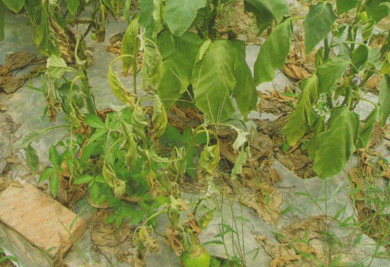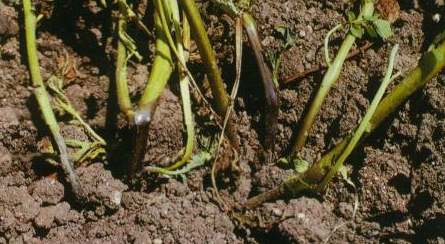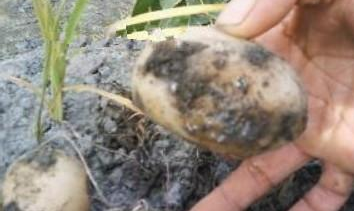Potato is an important food crop in China, and pests and diseases are one of the important factors affecting its yield. In recent years, potato virus disease and late blight have occurred more seriously, and bacterial diseases such as bacterial wilt and aphids have also occurred from time to time. The prevention and control of potato pests and diseases should be based on prevention and adhere to comprehensive prevention and control. Huinong School focused on the identification and control of potato pests and diseases, and hoped to help farmers. Fungal disease Late blight Potato late blight is common in all parts of the country and is seriously harmful. Late blight In the past, most of the disease occurred in protected areas, but in recent years, especially in the rainy years - all seasons can occur. When the disease occurs seriously, the leaves are wilting and the whole plant is dead. Symptoms: The diseased leaves initially showed dark green small lesions at the tip and leaf margin. Under conditions that are favorable for the onset of disease, the lesions rapidly expanded and were water-immersed irregular dark green. The diseased spot, the edge of the diseased leaf is curled up and dried, and the edge of the lesion on the back of the leaf can be seen as a layer of downy mildew formed by the pathogenic bacteria. When the disease is serious, the leaves sag, and most of the leaves die and fall off, leaving only a few green leaves at the top. Under high temperature and drought conditions, the lesions stop expanding and form necrotic areas. The affected tuber has small brown spots on its surface. Gradually enlarged to form a slightly concave dark brown irregular lesion. After the diseased potato is cut, a layer of brown dry tissue extending from the surface inward by about 1 cm can be seen. Diseased potatoes are often rotted with secondary microorganisms under high temperature and humidity conditions. Route of transmission: The pathogens are overwintered in the storage tubers or discarded tubers by the hyphae. After sowing in the next year, they invade the stems and leaves with the growth of the young shoots, and then form conidia (spore sacs), which are transmitted by air or running water. After the conidia absorb water, usually 6 to 12 zoospores are formed. Zoospores can germinate from the leaf stomata to invade the host with germ cells. Conidia or zoospores can also penetrate into the soil with rain or irrigation water, invading tubers from wounds or lenticels. Late blight is mad The temperature is about 20 °C, and the humidity is the most popular. Prevention: 1. Choose resistant varieties. 2. Use disease-free seed potatoes. 3. According to the local disease incidence, determine the pre-injection prevention before the onset, and then apply the drug 1 or 2 times every 2 to 3 weeks. Verticillium wilt Symptoms: This disease causes early infection of the plant. blade It is chlorotic, yellow, and withered. The vascular bundle of the stem turns pale brown, sometimes showing necrotic streaks at the base of the stem. The tuber vascular bundle ring is light brown with irregular plaque on the surface and pink or tan around the bud. When severe, it can cause voids in the tuber. Routes of transmission: The contaminated soil adhering to the tubers, the susceptible tubers, and the susceptible weeds can be transmitted. Conidia can also be transmitted through the air stream. The pathogens invade mainly through root hairs, wounds, branches and leaves. Control measures: 1. Select resistant varieties. 2. Rotate with grass or legume crops to avoid rotation with Solanaceae crops. 3. Prevent diseased weeds such as dandelions and leeks. The above are common bacterial and fungal diseases. They are not only found in production. If there is no good storage condition, they are also susceptible to infection. Therefore, temperature and humidity must be paid attention to during storage. Generally, the temperature is controlled between 0 °C and 4 °C. Humidity is suitable from 65% to 85%. The storage should be ventilated and ventilated to reduce the concentration of carbon dioxide, avoiding the increase of temperature and humidity during storage, affecting the physiological activities of potato chips, causing the germination and infection of the bacteria, leading to the decay of potato chips. . Bacterial disease Black plague Symptoms: The affected plants usually start from decaying seed potatoes. The upper part of the stem expands, the inner part of the stem is black and rotted, and the vascular bundle is discolored. The growth dwarfed and stiff, the early damaged leaves chlorotic, the top leaves edge curled upward, and the whole plant gradually withered and died. Late onset plants develop disease susceptibility Different potato pieces, the transverse section of the diseased potato can see the vascular bundle turns black. Light is only discolored in the umbilicus, and the potato stalks that are ill-healed have become black and rotten in the field and have a bad smell. Route of transmission: The first dip of the disease mainly comes from the surface of the seed potato or the inside of the seed potato. After planting, the seed potato rots and releases a large amount of bacteria into the soil. Bacteria live in the soil for a short period of time, moving through soil and water for short distances and infecting nearby host stems and developing seed potatoes. During the growing season, bacteria can add value and persist in the rhizosphere of the host or some weeds. Residual bacteria in the soil after harvest or Overwintering on diseased tubers during storage. Wounds caused by cutting seed potatoes and mechanical manipulation and insect damage are the main vectors. Prevention: 1. Select resistant varieties, strictly implement quarantine, and prevent the introduction of diseased potatoes. 2. Choose sand loam soil for planting. 3. Available planting small whole potatoes, cut into pieces before sowing seed to a rigorous selection process, remove disease, injury tubers, such as the cut heal planting. 4. It is necessary to excavate the diseased plants in the field and apply lime disinfection in the empty nest. The harvested potato pieces and plant residues are removed from the field at harvest . Soft rot Symptoms: Potato chips rot in late growth and storage. Potato stems and tubers can be infested through lenticels and wounds. There are dark brown streaks on the plants, and the stalks are rotted and formed in severe cases. Hollow and lodging, the diseased tuber epidermis is light brown, followed by soft rot, stench. Route of transmission: Soft rot infection is similar to black smut, pathogenic bacteria are high Temperature and humidity conditions are most suitable for the disease. Bacteria survive in the soil for up to 3 years. Bacteria are often spread by washing the tuber wounds. Tuber immature, injured, sun-irradiated and other fungi, warm, high-humidity and hypoxia, excessive application of nitrogen fertilizer are conducive to soft rot infection. Prevention: 1. Strengthen the cultivating soil before harvesting, pay attention to the drainage in the field to reduce the infection of the lenticels. 2. Mature tubers avoid manual and mechanical damage during harvesting and shipping, prevent direct sunlight, store in low temperature, dry, well ventilated places, and should not rinse the tubers with water before storage. We are a professional Chinese manufacturer of Anti-Cancer Ingredients;we supply various products of Anti-Tumor Materials, and can providing product images and basic parameters with each Anti-Neoplasm Ingredients and Anti-Mutation Ingredients, such as Betulinic Acid, Genipin 98%, Kaempferol 98%, Pterostilbene 98%. Look forward to your cooperation! Anti-Tumor Materials,Betulinic Acid,Genipin 98%,Kaempferol 98%,Pterostilbene 98% Xi'an Quanao Biotech Co., Ltd. , https://www.quanaobio.com


